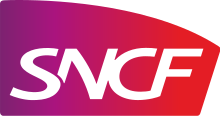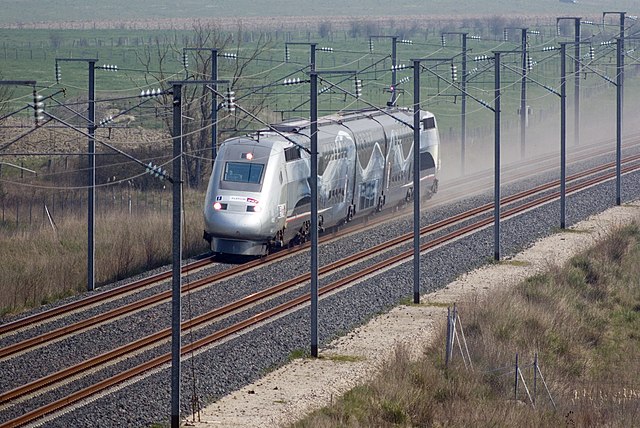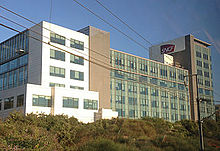Loading AI tools
National state-owned railway company of France From Wikipedia, the free encyclopedia
The Société nationale des chemins de fer français (French pronunciation: [sɔsjete nɑsjɔnal de ʃ(ə)mɛ̃ d(ə) fɛʁ fʁɑ̃sɛ]; abbreviated as SNCF [ɛsɛnseɛf]; lit. "National Company of the French Railways") is France's national state-owned railway company. Founded in 1938, it operates the country's national rail traffic along with that of Monaco, including the TGV, on France's high-speed rail network. Its functions include operation of railway services for passengers and freight (through its subsidiaries SNCF Voyageurs and Rail Logistics Europe), as well as maintenance and signalling of rail infrastructure (SNCF Réseau). The railway network consists of about 35,000 km (22,000 mi) of route, of which 2,600 km (1,600 mi) are high-speed lines and 14,500 km (9,000 mi) electrified. About 14,000 trains are operated daily.
 | |
 Map of the French railways on which the TGV (LGV: blue; normal tracks: black) and Intercités (grey) SNCF trains run. | |
 | |
| Overview | |
|---|---|
| Headquarters | Saint-Denis, France |
| Reporting mark | TGV, Intercités, TER, Transilien, Ouigo, Eurostar, TGV Lyria |
| Locale | France |
| Dates of operation | 1938–present |
| Predecessor | Compagnie des chemins de fer du Nord Administration des chemins de fer d'Alsace et de Lorraine Compagnie des chemins de fer de Paris à Lyon et à la Méditerranée Compagnie du chemin de fer de Paris à Orléans Compagnie des chemins de fer du Midi et du Canal latéral à la Garonne Compagnie des chemins de fer de l'Est Administration des chemins de fer de l'État |
| Technical | |
| Track gauge | 1,435 mm (4 ft 8+1⁄2 in) and 1,000 mm (3 ft 3+3⁄8 in) |
| Length | 29,273 km (18,189 mi) |
| Other | |
| Website | www.groupe-sncf.com |
 | |
| Company type | State-owned société anonyme EPIC between 1983 and 2019[1] |
|---|---|
| Industry | Rail transport |
| Founded | 1 January 1938 |
| Founder | Government of France |
| Headquarters | , France |
Key people | Jean-Pierre Farandou (president of SNCF Group) |
| Revenue | |
| Total assets | |
| Total equity | |
| Owner | French state |
Number of employees | 270,296 (2021)[2] |
| Subsidiaries |
|
In 2010 the SNCF was ranked 22nd in France and 214th globally on the Fortune Global 500 list.[3] It is the main business of the SNCF Group, which in 2020 had €30 billion of sales in 120 countries.[4] The SNCF Group employs more than 275,000 employees in France and around the world.[5] Since July 2013, the SNCF Group headquarters are located in a Parisian suburb at 2 Place aux Étoiles in Saint-Denis. The president of SNCF Group has been Jean-Pierre Farandou since 2019.


SNCF operates almost all of France's railway traffic, including the TGV (Train à Grande Vitesse, meaning "high-speed train"). In the 1970s, the SNCF began the TGV high-speed train program with the intention of creating the world's fastest railway network. It came to fruition in 1981 with the completion of the first high-speed line LGV Sud-Est ("Ligne à Grande Vitesse Sud-Est", meaning "southeast high-speed line"), where the first TGV service, from Paris to Lyon, was inaugurated. In 2017, the national rail network owned by SNCF Réseau had 28,710 km (17,839 mi) of lines, 58% of which were electrified and 2,640 high-speed lines. Every day, the SNCF runs 15,000 commercial trains and transports more than 5 million passengers and more than 250,000 tonnes of goods.[6] TGV lines and TGV technology are now spread across several European countries.
The SNCF's TGV has set many world speed records, the most recent on 3 April 2007, when a new version of the TGV dubbed the V150 with larger wheels than the usual TGV, was able to cover more ground with each rotation and had a stronger 18,600-kilowatt (24,900-horsepower) engine, and broke the world speed record for conventional railway trains, reaching 574.8 km/h (357.2 mph).
The SNCF has a remarkable safety record. After nearly 30 years in operation, SNCF's TGV system has only experienced one fatal accident, which occurred during pre-opening testing and not in regular operation.
In 2011 SNCF in partnership with Keolis, unsuccessfully bid for the InterCity West Coast franchise.[7] In April 2017 SNCF took a 30% shareholding in a joint venture with Stagecoach Group and Virgin Group to bid for the West Coast Partnership that will operate services on the West Coast Main Line from May 2020 and the High Speed 2 line from 2026.[8][9]
In April 2019 Stagecoach were banned from bidding for any franchises including the West Coast Partnership which has meant that Virgin and SNCF have now had to withdraw from the shortlist.
Since the 1990s, SNCF has been selling railway carriages to regional governments, with the creation of the Train Express Régional brand. SNCF also maintains a broad scope of international business that includes work on freight lines, inter-city lines and commuter lines. SNCF experts provide logistics, design, construction, operations and maintenance services. SNCF operates the international ticketing agency SNCF Connect, formerly oui.sncf/Voyages-sncf.com and Rail Europe, previously Loco 2.
SNCF has employees in 120 countries offering extensive overseas and cross border consulting. Those projects include

SNCF was formed in 1938 with the nationalisation of France's main railway companies (Chemin de fer, literally, 'way of iron', means railway). These were the:
The French state originally took 51% ownership of SNCF and invested large amounts of public subsidies into the system. Today, SNCF is wholly owned by the French state.
Following the 1940 Armistice and until August 1944, SNCF was requisitioned for the transport of German armed forces and armaments. The invading German troops were responsible for the destruction of nearly 350 French railway bridges and tunnels. According to differing estimates, SNCF surrendered between 125,000 and 213,000 wagons and 1,000–2,000 locomotives.[10][11]

France's railway infrastructure and rolling stocks were a target for the French Resistance aimed at disrupting and fighting the German occupying forces.[12][13] This allowed SNCF employees to perform many acts of resistance,[14] including the formation of the Résistance-Fer movement in 1943. Nearly 1,700 SNCF railway workers were killed or deported for resisting Nazi orders.[15][16] 150 Résistance-Fer agents were shot for their acts of resistance, 500 of them were deported. Half of those deported died in concentration camps.[17]
German occupying forces in France also requisitioned SNCF to transport nearly 77,000 Jews and other Holocaust victims to Nazi extermination camps.[18][19] These deportations have been the subject of historical controversy and lawsuits (such as the Lipietz case) in France as well as in the United States (where subsidiary Keolis is a transportation contractor) to the present day.[16][20]
In 1992 SNCF commissioned French academics to write a history of SNCF activities during World War II. The resultant report was published in 1996.[21][22]
More recently, some sources have claimed that SNCF billed Nazi-occupied France for third-class tickets for Holocaust victims transported to extermination camps,[23][24] although passengers were transported in cattle cars.[25] Other sources have reported that after the liberation of France SNCF continued to seek payment for transporting Holocaust victims to Germany.[23][26] However, historian Michael Marrus has written that claims that SNCF billed for third-class tickets and continued to seek payment after the war ended were made as part of a legal case brought against SNCF, and did not match with historians' understanding of what happened. Marrus argues that SNCF had no margin of maneuver during the German occupation and that the actions of SNCF employees were not ideologically motivated.[19] According to Serge Klarsfeld, president of the organization Sons and Daughters of Jewish Deportees from France, SNCF was forced by German and Vichy authorities to cooperate in providing transport for French Jews to the border and did not make any profit from this transport.[27]
In December 2014, SNCF agreed to pay up to $60 million worth of compensation to Holocaust survivors in the United States.[28] It corresponds to approximately $100,000 per survivor.[29]
In the early 2000s, SNCF sought to get a contract from the state of California for a bullet train project between Los Angeles and San Francisco. SNCF recommended that the train take the most direct route between the two locations to reduce the complexity and cost of the project, but the SNCF's recommendations were cast aside by California politicians who wanted to divert the train through various communities, raising the cost and complexity of the project, as well as the expected travel time. SNCF pulled out of the project in 2011 and went to Morocco to help the country construct a bullet train service. By 2018, Morocco's bullet train started service while the California bullet train project was not close to being operational in 2022, with some saying that the project would never be completed.[30]
In May 2014, the company had discovered that 2,000 new trains they ordered at a cost of 15 billion euros are too wide for many of France's regional platforms. Construction work has started to reconfigure them.[31]
On 1 January 2015, Réseau ferré de France (RFF) merged with SNCF Infra and the Direction de la circulation ferroviaire (DCF) and became SNCF Réseau, the operational assets of SNCF became SNCF Mobilités, and both groups were placed under the control of SNCF.
Jean-Pierre Farandou, the head of the state-owned railway operator, SNCF informed on 26 July 2024 that its high-speed rail network Eurostar suffered from multiple instances of coordinated sabotage, causing significant disruptions to train services. The incident occurred just hours before the opening ceremony of the Olympics, which was considered a high-risk event. The affected lines were located in the western, northern, and eastern regions of France, impacting not only domestic trains but also those travelling to neighboring Belgium and London via the Channel Tunnel. It was expected that roughly 800,000 travellers were impacted because of this arson attack on french railway networks.[32][33][34][35]

The industrial designer Paul Arzens styled many of SNCF's locomotives from the 1940s until the 1970s. A particularly distinctive type is the "broken nose" style of electric and diesel locomotives.
SNCF codeshares with Air Austral, Air France, Air Tahiti Nui, American Airlines, Cathay Pacific, Middle East Airlines, Etihad Airways, Qatar Airways, and SriLankan Airlines. In exchange, SNCF allows passengers on these flights to book railway services between Charles de Gaulle Airport in Roissy (near Paris) and Aix-en-Provence, Angers, Avignon, Bordeaux, Le Mans, Lille, Lyon Part-Dieu, Marseille, Montpellier, Nantes, Nîmes, Poitiers, Rennes, Strasbourg, Tours, and Valence with their airline. The IATA designator used by airlines in connection with these journeys is 2C.[citation needed]
Continental Airlines discontinued its codeshare with SNCF on 15 August 2010.[36]


Until 1999, the SNCF's historic headquarters was located at 88 Rue Saint-Lazare in the 9th arrondissement.[37][38] In 1996 the chairman of SNCF, Louis Gallois, announced that SNCF would move its headquarters to a new location during the middle of 1997.[39]
From 1999 to 2013, SNCF's headquarters were located in the Montparnasse neighborhood of the 14th arrondissement of Paris,[40] located near the Gare Montparnasse.[37]
Since July 2013, the SNCF headquarters are located in the Parisian suburb of Saint-Denis at 2, place aux Étoiles, 93200 Saint Denis.[citation needed] The move was motivated by cutting operating costs by 10 million euros per year.[41]
Since 1 January 2020 SNCF is a state-owned group consisting of a parent company (SNCF) with several independently operated subsidiaries:

SNCF has full or partial shares in a large number of companies, the majority of which are rail or transport related. These include:[42]
General freight transport:
Passenger transport
Tickets
Consulting
Housing
According to a TNS SOFRES survey published in 2010, 66% of French people have a good image of SNCF.[46] At the end of 2019, this proportion was measured at 50% by the Posternak-Ifop barometer on the image of companies.[47] In 2020, Eight Advisory and IFOP unveil their ranking of the "most admired French companies": SNCF is in 23rd position.[48]
Safety on trains is also often a priority. To do this, around 2,800 railway workers form the Railway Security, the general supervision of SNCF, of which 50% of the workforce is assigned to the Île-de-France region.
Furthermore, the experts of the BCG, Boston Consulting Group, use to compare the rail systems in 25 European countries. They rank France in tied 4th position (with Germany, Austria and Sweden), behind Switzerland, Denmark and Finland. The criteria are : the utilization rate, quality of service and safety.[49]
SNCF's current visual logo was created in 2005 by the Carré Noir agency, a subsidiary of the Publicis communication group. It was slightly reworked in 2011: rounded corners, disappearance of shadows inside the letters as well as behind, and a clearer separation between them.
The SNCF sound logo – the four notes C – G – A flat – E flat –, in a sung version,[50] was created in 2005 by Michaël Boumendil.[51] David Gilmour, guitarist of the group Pink Floyd, used the jingle as the inspiration for the title track of his 2015 album Rattle That Lock.[52] Simone Hérault has been the voice of SNCF since 1981.[53]
Since the Auguste and Louis Lumière's first film, SNCF has been the company that hosts the most film shoots in France,[54] between 50 and 60 shoots per year, which represents around two thirds of French productions.[55] A selection of iconic films where SNCF is at the heart of the matter include:
Seamless Wikipedia browsing. On steroids.
Every time you click a link to Wikipedia, Wiktionary or Wikiquote in your browser's search results, it will show the modern Wikiwand interface.
Wikiwand extension is a five stars, simple, with minimum permission required to keep your browsing private, safe and transparent.